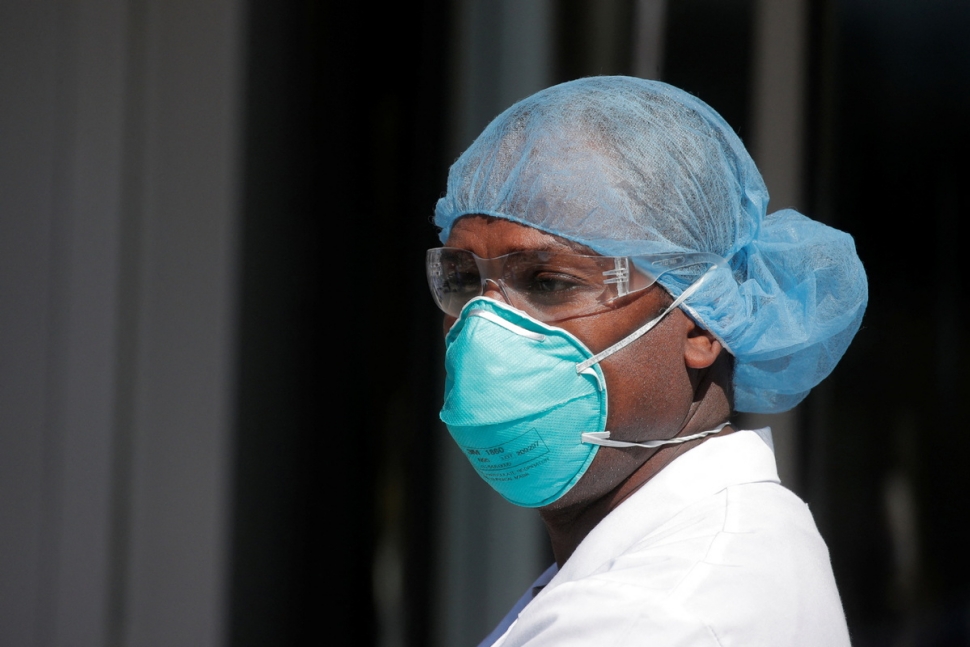trending topics
market reports
-

US to distribute 400 million free N95 masks at CVS, Walgreens in COVID fight
2022-01-21
-

Ethiopia receives additional 2.2 mln doses of Chinese-donated COVID-19 vaccines
2022-01-21
-

Hong Kong researchers say they develop novel material able to kill COVID-19 virus
2022-01-14
-

10 million more Chinese doses on way for Kenya
2022-01-14
-

Sino-African ties on track for a brighter future
2022-01-07
-

Efforts urged to boost COVID-19 vaccine production capacity in poor countries
2022-01-07
-

UAE approves Sinopharm's new protein-based COVID-19 vaccine
2022-01-07
-

UAE approves Sinopharm's new protein-based COVID-19 vaccine
2022-01-07
-

Zimbabwe buoyed by Chinese jabs
2021-12-31
-

Bangladesh to administer 40 mln doses of COVID-19 vaccines every month from January
2021-12-31
Chinese endoscopic diagnosis and treatment instruments
2022-08-23
The aging population is increasing, the penetration rate of endoscopic diagnosis and treatment in primary medical institutions is increasing, and the policy of medical consumables collection is implemented.
Driven by the multiple benefits of policy support and demand growth, Chinese endoscopic medical equipment enterprises should play their local advantages and expand the incremental market. In addition, relevant enterprises need to optimize and extend the service chain to promote the establishment and improvement of the domestic endoscopy system training system while improving the R&D and production capacity.
There are many segments
Medical endoscope (also known as endoscope) is a kind of medical instrument that enters the human body through the natural channel or through the surgical incision and can directly peek into the changes of the relevant parts. Endoscopy has a wealth of application scenarios, and has been widely used in the diagnosis and treatment of gastrointestinal tract, pancreatic biliary tract, respiratory tract, urinary tract and other diseases, such as gastroscopy, colonoscopy, bronchoscopy and microwave ablation. Among them, digestive tract is an important application field of endoscopy.
The common endoscopic system is mainly composed of endoscopic equipment and diagnosis and treatment equipment. Endoscopic equipment is often reusable, while diagnostic and treatment equipment matched with endoscopic equipment are usually disposable products, so the consumption is large.The endoscopic equipment is mainly composed of the host machine (including image processor, high-definition display screen, cold light source), the scope body (including gastroscope, colonoscope, duodenoscope, etc.), and peripheral equipment (including CO2 air delivery device, endoscopic water pump, etc.). Endoscopic diagnosis and treatment equipment refers to diagnostic or therapeutic medical instruments and consumable supplies that are used together with various types of endoscopic equipment, which are auxiliary and consumable. With the cooperation of endoscopic diagnosis and treatment equipment, doctors can perform dissection, cutting, expansion and other operations in the human body, making the implementation of complex minimally invasive surgery possible.
Endoscopes can be divided into rigid endoscopes (also known as hard endoscopes) and soft endoscopes (also known as soft endoscopes) according to the degree of softness and hardness of the mirror body and the classification of application scenarios. Hard lens mainly includes laparoscopy, thoracoscopy, arthroscopy and discoscopy. The main body of the hard lens can not be bent or twisted, and it mainly enters the sterile tissues and organs of the human body or the sterile chamber of the human body through surgical incision. Hard lens has clear imaging, and has advantages in difficult foreign body retrieval, stent placement and removal. Soft scopes mainly include gastroscopes, colonoscopes, bronchoscopes, etc., which are mainly diagnosed and treated through the natural cavity of the human body, such as entering the human body through the digestive tract and respiratory tract. Compared with the hard lens, the soft lens has a soft and slender body, which is more comfortable to use and can effectively reduce the physiological burden of patients, but its cost and technical barriers are high.
According to the classification of treatment fields, endoscopy can be divided into thoracoscopy, laparoscopy, arthroscopy, respiratory endoscopy and digestive endoscopy. Thoracoscopy and laparoscopy are more commonly used, mainly hard lenses. Digestive endoscopy is also an important application field of endoscopy, mainly soft endoscopy. Digestive endoscopy can be divided into gastroscopy, colonoscopy, duodenoscopy and so on.Huge space for demand
At present, patients with diseases of digestive system are increasing day by day in our country, especially the incidence of cancer of digestive tract, which greatly promotes the release of the demands of endoscopic diagnosis and treatment. About 4.064 million new cancer cases were diagnosed in China in 2016, including 408,000 new cases of colorectal cancer, 397,000 new cases of gastric cancer and 253,000 new cases of esophageal cancer, according to the National Cancer Center.
In addition, according to GI Obal Cancer, in 2018, the number of new gastric Cancer cases in China accounted for 44% of the global total, and the number of new colorectal Cancer cases accounted for 28% of the global total. In addition, a study published in the Lancet Gastroenterology and Hepatology showed that in 2018, the number of new esophageal cancer cases in China accounted for nearly 50% in the world.
At the same time, the increasing aging of the population also promotes the growing demand for endoscopic diagnosis and treatment. As the incidence and mortality of cancer are highly correlated with age, with the acceleration of the aging process of our population, the incidence and mortality of digestive tract cancer will continue to rise, and the number of patients who need endoscopic diagnosis and treatment will continue to increase.
The size of the market is growing rapidly。The size of the market is growing rapidly
With the upgrade and selection of medical devices in the field of diagnosis and treatment of digestive diseases and minimally invasive surgery worldwide, the market size of the endoscopy industry is constantly expanding. Eval uate According to MedTech, the global endoscopic systems market size was approximately US $18.5 billion in 2017: It is expected to reach US $28.3 billion by 2024 at a CAGR of 6.3%, which is expected to be higher than the total global medical device sales growth during the same period, making it the fastest growing medical device sub-industry in the world.
The market size of endoscopy system has also increased rapidly in China. Data from Everbright Securities show that in 2021, China's endoscopic system market size was about 10.71 billion yuan; The market size is expected to grow to about 14.78 billion yuan by 2024. Among them, the market size of endoscopic equipment and medical equipment in 2021 was about 6.06 billion yuan and 4.65 billion Yuan respectively; With the continuous increase of endoscopic diagnosis and treatment cases, especially the increasing penetration rate of endoscopic diagnosis and treatment in primary medical institutions, the market size of the two sub-industries will further grow, and is expected to reach 7.5 billion Yuan and 7.28 billion Yuan respectively by 2024 (see the figure for details).Industrial and service chains need to develop together
Currently, the process of domestic production of endoscopy system is accelerated. In terms of endoscopic equipment, domestic brands have achieved technological breakthroughs in the fields of optical imaging and mirror system manufacturing, which has a certain basis of import substitution. At the same time, primary medical institutions are currently the main incremental market for endoscopic equipment. Domestic brands with local advantages can tap this huge incremental market and further improve the penetration rate and allocation rate of endoscopic equipment in primary medical institutions, which will also be conducive to the rational allocation of medical resources.
In terms of diagnosis and treatment equipment, the performance of domestic products is relatively mature, and the selection and upgrading speed is accelerated. Domestic brands can continue to play to local advantages and quickly meet market demand. At the same time, under the promotion of the collection policy of medical consumables, cheap and high-quality domestic endoscopic diagnosis and treatment equipment has gradually entered the accelerated period of import substitution.
It should be noted that due to the long training cycle of endoscopists, at present, China is in short supply of endoscopists, far from meeting the needs of diagnosis and treatment, which restricts the development of the industry to a certain extent. At the same time, the training system based on domestic endoscopic products needs to be established and improved. Endoscopy products have high hidden conversion cost and user viscosity. Endoscopists have formed operating habits during training, and it is difficult to adapt to other products in the short term. Therefore, after breaking through the technical bottleneck of endoscope product development and production, the improvement of product use training services may become the key development direction of related enterprises. (Contributed by Gaohe Investment Research Center)
Source Publications:www.ChinaMedevice.cn
Driven by the multiple benefits of policy support and demand growth, Chinese endoscopic medical equipment enterprises should play their local advantages and expand the incremental market. In addition, relevant enterprises need to optimize and extend the service chain to promote the establishment and improvement of the domestic endoscopy system training system while improving the R&D and production capacity.

There are many segments
Medical endoscope (also known as endoscope) is a kind of medical instrument that enters the human body through the natural channel or through the surgical incision and can directly peek into the changes of the relevant parts. Endoscopy has a wealth of application scenarios, and has been widely used in the diagnosis and treatment of gastrointestinal tract, pancreatic biliary tract, respiratory tract, urinary tract and other diseases, such as gastroscopy, colonoscopy, bronchoscopy and microwave ablation. Among them, digestive tract is an important application field of endoscopy.
The common endoscopic system is mainly composed of endoscopic equipment and diagnosis and treatment equipment. Endoscopic equipment is often reusable, while diagnostic and treatment equipment matched with endoscopic equipment are usually disposable products, so the consumption is large.The endoscopic equipment is mainly composed of the host machine (including image processor, high-definition display screen, cold light source), the scope body (including gastroscope, colonoscope, duodenoscope, etc.), and peripheral equipment (including CO2 air delivery device, endoscopic water pump, etc.). Endoscopic diagnosis and treatment equipment refers to diagnostic or therapeutic medical instruments and consumable supplies that are used together with various types of endoscopic equipment, which are auxiliary and consumable. With the cooperation of endoscopic diagnosis and treatment equipment, doctors can perform dissection, cutting, expansion and other operations in the human body, making the implementation of complex minimally invasive surgery possible.
Endoscopes can be divided into rigid endoscopes (also known as hard endoscopes) and soft endoscopes (also known as soft endoscopes) according to the degree of softness and hardness of the mirror body and the classification of application scenarios. Hard lens mainly includes laparoscopy, thoracoscopy, arthroscopy and discoscopy. The main body of the hard lens can not be bent or twisted, and it mainly enters the sterile tissues and organs of the human body or the sterile chamber of the human body through surgical incision. Hard lens has clear imaging, and has advantages in difficult foreign body retrieval, stent placement and removal. Soft scopes mainly include gastroscopes, colonoscopes, bronchoscopes, etc., which are mainly diagnosed and treated through the natural cavity of the human body, such as entering the human body through the digestive tract and respiratory tract. Compared with the hard lens, the soft lens has a soft and slender body, which is more comfortable to use and can effectively reduce the physiological burden of patients, but its cost and technical barriers are high.
According to the classification of treatment fields, endoscopy can be divided into thoracoscopy, laparoscopy, arthroscopy, respiratory endoscopy and digestive endoscopy. Thoracoscopy and laparoscopy are more commonly used, mainly hard lenses. Digestive endoscopy is also an important application field of endoscopy, mainly soft endoscopy. Digestive endoscopy can be divided into gastroscopy, colonoscopy, duodenoscopy and so on.Huge space for demand
At present, patients with diseases of digestive system are increasing day by day in our country, especially the incidence of cancer of digestive tract, which greatly promotes the release of the demands of endoscopic diagnosis and treatment. About 4.064 million new cancer cases were diagnosed in China in 2016, including 408,000 new cases of colorectal cancer, 397,000 new cases of gastric cancer and 253,000 new cases of esophageal cancer, according to the National Cancer Center.
In addition, according to GI Obal Cancer, in 2018, the number of new gastric Cancer cases in China accounted for 44% of the global total, and the number of new colorectal Cancer cases accounted for 28% of the global total. In addition, a study published in the Lancet Gastroenterology and Hepatology showed that in 2018, the number of new esophageal cancer cases in China accounted for nearly 50% in the world.
At the same time, the increasing aging of the population also promotes the growing demand for endoscopic diagnosis and treatment. As the incidence and mortality of cancer are highly correlated with age, with the acceleration of the aging process of our population, the incidence and mortality of digestive tract cancer will continue to rise, and the number of patients who need endoscopic diagnosis and treatment will continue to increase.
The size of the market is growing rapidly。The size of the market is growing rapidly
With the upgrade and selection of medical devices in the field of diagnosis and treatment of digestive diseases and minimally invasive surgery worldwide, the market size of the endoscopy industry is constantly expanding. Eval uate According to MedTech, the global endoscopic systems market size was approximately US $18.5 billion in 2017: It is expected to reach US $28.3 billion by 2024 at a CAGR of 6.3%, which is expected to be higher than the total global medical device sales growth during the same period, making it the fastest growing medical device sub-industry in the world.
The market size of endoscopy system has also increased rapidly in China. Data from Everbright Securities show that in 2021, China's endoscopic system market size was about 10.71 billion yuan; The market size is expected to grow to about 14.78 billion yuan by 2024. Among them, the market size of endoscopic equipment and medical equipment in 2021 was about 6.06 billion yuan and 4.65 billion Yuan respectively; With the continuous increase of endoscopic diagnosis and treatment cases, especially the increasing penetration rate of endoscopic diagnosis and treatment in primary medical institutions, the market size of the two sub-industries will further grow, and is expected to reach 7.5 billion Yuan and 7.28 billion Yuan respectively by 2024 (see the figure for details).Industrial and service chains need to develop together
Currently, the process of domestic production of endoscopy system is accelerated. In terms of endoscopic equipment, domestic brands have achieved technological breakthroughs in the fields of optical imaging and mirror system manufacturing, which has a certain basis of import substitution. At the same time, primary medical institutions are currently the main incremental market for endoscopic equipment. Domestic brands with local advantages can tap this huge incremental market and further improve the penetration rate and allocation rate of endoscopic equipment in primary medical institutions, which will also be conducive to the rational allocation of medical resources.
In terms of diagnosis and treatment equipment, the performance of domestic products is relatively mature, and the selection and upgrading speed is accelerated. Domestic brands can continue to play to local advantages and quickly meet market demand. At the same time, under the promotion of the collection policy of medical consumables, cheap and high-quality domestic endoscopic diagnosis and treatment equipment has gradually entered the accelerated period of import substitution.
It should be noted that due to the long training cycle of endoscopists, at present, China is in short supply of endoscopists, far from meeting the needs of diagnosis and treatment, which restricts the development of the industry to a certain extent. At the same time, the training system based on domestic endoscopic products needs to be established and improved. Endoscopy products have high hidden conversion cost and user viscosity. Endoscopists have formed operating habits during training, and it is difficult to adapt to other products in the short term. Therefore, after breaking through the technical bottleneck of endoscope product development and production, the improvement of product use training services may become the key development direction of related enterprises. (Contributed by Gaohe Investment Research Center)
Source Publications:www.ChinaMedevice.cn
label :
Medical Device



 My Member
My Member Message Center
Message Center











